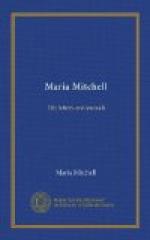“... Only a few weeks since I received a letter from a lady who wished to come to make me a visit, and to ‘scan the heavens,’ as she termed it. Now, just as she wrote, the clock, which I was careful not to meddle with, had been rapidly gaining time, and I was standing before it, watching it from hour to hour, and slightly changing its rate by dropping small weights upon its pendulum. Time is so important an element with the astronomer, that all else is subordinate to it.
“Then, too, the uneducated assume the unvarying exactness of mathematical results; while, in reality, mathematical results are often only approximations. We say the sun is 91,000,000 miles from the earth, plus or minus a probable error; that is, we are right, probably, within, say, 100,000 miles; or, the sun is 91,000,000 minus 100,000 miles, or it is 91,000,000 plus 100,000 miles off; and this probable error is only a probability.
“If we make one more observation it cannot agree with any one of our determinations, and it changes our probable error.
[Illustration: BUST OF MARIA MITCHELL.
From Original made by Miss Emma F. Brigham in 1877]
“This ignorance of the masses leads to a misconception in two ways; the little that a scientist can do, they do not understand,—they suppose him to be godlike in his capacity, and they do not see results; they overrate him and they underrate him—they underrate his work.
“There is no observatory in this land, nor in any land, probably, of which the question is not asked, ’Are they doing anything? Why don’t we hear from them? They should make discoveries, they should publish.’
“The one observation made at Greenwich on the planet Neptune was not published until after a century or more—it was recorded as a star. The observation had to wait a hundred years, about, before the time had come when that evening’s work should bear fruit; but it was good, faithful work, and its time came.
“Kepler was years in passing from one of his laws to another, while the school-boy, to-day, rattles off the three as if they were born of one breath.
“The scientist should be free to pursue his investigations. He cannot be a scientist and a school-master. If he pursues his science in all his intervals from his class-work, his classes suffer on account of his engrossments; if he devotes himself to his students, science suffers; and yet we all go on, year after year, trying to work the two fields together, and they need different culture and different implements.
“1878. In the eclipse of this year, the dark shadow fell first on the United States thirty-eight degrees west of Washington, and moved towards the south-east, a circle of darkness one hundred and sixteen miles in diameter; circle overlapping circle of darkness until it could be mapped down like a belt.
“The mapping of the dark shadow, with its limitations of one hundred and sixteen miles, lay across the country from Montana, through Colorado, northern and eastern Texas, and entered the Gulf of Mexico between Galveston and New Orleans. This was the region of total eclipse. Looking along this dark strip on the map, each astronomer selected his bit of darkness on which to locate the light of science.




